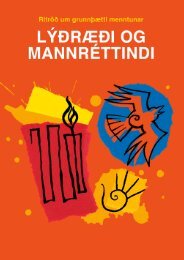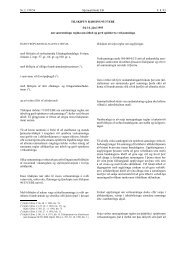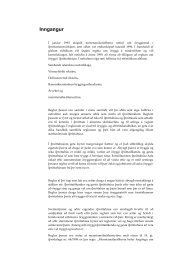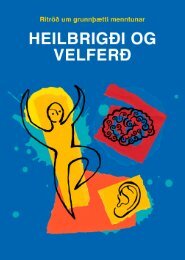Arts and Cultural Education in Iceland : Professor Anne Bamford
Arts and Cultural Education in Iceland : Professor Anne Bamford
Arts and Cultural Education in Iceland : Professor Anne Bamford
Create successful ePaper yourself
Turn your PDF publications into a flip-book with our unique Google optimized e-Paper software.
languages; Icel<strong>and</strong>ic <strong>and</strong> mathematics account for, respectively, 19 <strong>and</strong> 17 percent; <strong>and</strong>, science<br />
accounts for 9 percent. Given these figures, it would appear that adequate curriculum focus is<br />
given to the arts with<strong>in</strong> Icel<strong>and</strong>ic education with around 1/3 of school time dedicated to the arts<br />
(<strong>in</strong>clud<strong>in</strong>g wood <strong>and</strong> textile). The usual pattern of time is 2 x 40 m<strong>in</strong>utes per week for each arts<br />
subject, though this can vary considerably from school to school. This comparatively high<br />
allocation <strong>in</strong> compulsory school for arts education seems to be a favoured part of Icel<strong>and</strong>ic<br />
education as this parent comment (typical of many similar comments made by a variety of<br />
respondents) suggests: “It is important that art is a part of the compulsory curriculum. That way<br />
it does not depend on the economies of the family. I th<strong>in</strong>k we are miss<strong>in</strong>g some talent if we<br />
count only on the after school courses <strong>in</strong> music schools.”<br />
In 2011 there will be a new Bill (law) for high schools. Each school can create their own l<strong>in</strong>es<br />
for subjects. While some of the research respondents saw this change as a positive move that<br />
should allow more creativity <strong>in</strong>to the curriculum, other people felt that it would lead to a<br />
reduction <strong>in</strong> the scope <strong>and</strong> quality of arts education <strong>in</strong> schools, as this comment from a school<br />
pr<strong>in</strong>cipal suggests:<br />
This change might be a good th<strong>in</strong>g. But that is a big question about the place of the arts. I th<strong>in</strong>k it could be a<br />
problem for smaller schools. They have to serve everyone, but they will have less choice of what they can offer. I<br />
worry that what we will f<strong>in</strong>d is that everyth<strong>in</strong>g will be cut. The arts will be viewed as a luxury. Less than 50% of<br />
schools are teach<strong>in</strong>g accord<strong>in</strong>g to the official curricula.<br />
It was also felt that the ready adoption of the arts with<strong>in</strong> the new curriculum framework<br />
might be adversely effected by the current economic climate (as is covered <strong>in</strong> more detail <strong>in</strong><br />
section 1.6 that follows).<br />
1.6 F<strong>in</strong>anc<strong>in</strong>g patterns<br />
‣ In 1996 many aspects of cultural <strong>and</strong> educational fund<strong>in</strong>g moved from the National<br />
M<strong>in</strong>istry to become the responsibility of the municipality, region or city.<br />
‣ The <strong>in</strong>herent complexities of fund<strong>in</strong>g directly impacts on the plann<strong>in</strong>g, delivery <strong>and</strong><br />
monitor<strong>in</strong>g of arts <strong>and</strong> cultural education<br />
‣ While the f<strong>in</strong>ancial support for education <strong>in</strong>dicates a high level commitment to<br />
education, it is unclear the amount of fund<strong>in</strong>g to arts <strong>and</strong> education with<strong>in</strong> the global<br />
fund<strong>in</strong>g model<br />
‣ Parents make considerable f<strong>in</strong>ancial contributions to arts <strong>and</strong> cultural education<br />
‣ The physical resources <strong>in</strong> schools <strong>and</strong> after school arts <strong>and</strong> cultural centres are of a<br />
high st<strong>and</strong>ard<br />
A jo<strong>in</strong>t study from the M<strong>in</strong>istry of <strong>Education</strong>, Science <strong>and</strong> Culture <strong>and</strong> the Icel<strong>and</strong>ic Central<br />
Bank (conducted <strong>in</strong> late December 2008) exam<strong>in</strong>ed arts <strong>and</strong> culture expenditure <strong>in</strong> Icel<strong>and</strong> (by<br />
the state <strong>and</strong> municipalities) dur<strong>in</strong>g the period 1998 to 2007. The study <strong>in</strong>dicates that public<br />
expenditure <strong>in</strong> Icel<strong>and</strong> (state <strong>and</strong> municipalities comb<strong>in</strong>ed) towards arts <strong>and</strong> culture has almost<br />
doubled from 1998 on a fixed rate scale (count<strong>in</strong>g for <strong>in</strong>flation). Concurrently, the per capita<br />
expenditure by the state (on a fixed rate) went from about 12.600 ISK <strong>in</strong> 1998 to <strong>in</strong> excess of<br />
22.000 ISK <strong>in</strong> 2007. Comparable figures for the municipalities were about 7.000 ISK <strong>in</strong> 1998, to<br />
about 13.000 ISK <strong>in</strong> 2002 <strong>and</strong> close to 17.900 <strong>in</strong> 2007. The study also exam<strong>in</strong>ed expenditure on<br />
cultural matters <strong>in</strong> 2005 <strong>in</strong> Icel<strong>and</strong> compared to the other Nordic countries as a proportion of<br />
GDP. In this comparison, Icel<strong>and</strong> was the highest with 0.85% of GDP. This was followed by<br />
Norway (0.71%); Denmark (0.60%); F<strong>in</strong>l<strong>and</strong> (0.59%) <strong>and</strong> lastly Sweden (0.47%). Although still at<br />
the top of Nordic expenditure, this figure for Icel<strong>and</strong> <strong>in</strong> 2005 was lower than for the years<br />
immediately before <strong>and</strong> after, where the average for the years 2005-2007 <strong>in</strong> Icel<strong>and</strong> was 0.91%.<br />
22



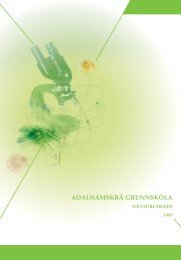
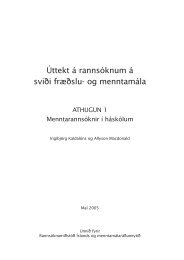

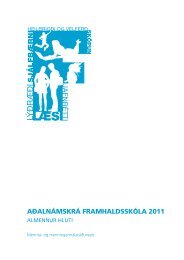
![Aðalnámskrá tónlistarskóla : rytmÃsk tónlist [Eingöngu á rafrænu formi]](https://img.yumpu.com/50843672/1/184x260/aaalnamskra-tanlistarskala-rytma-sk-tanlist-eingangu-a-rafranu-formi.jpg?quality=85)
